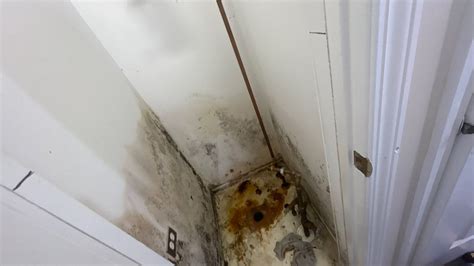
A Houston couple’s dream of owning a brand-new home in a gated community has allegedly devolved into a mold-infested nightmare, leading to health problems and legal action against the home builder, Perry Homes. Mario and Tanya Plascencia claim their recently constructed residence at the Pomona community in Manvel, Texas, has been plagued by extensive mold contamination since shortly after they moved in, rendering parts of the house uninhabitable and triggering significant health issues.
The Plascencias assert they began noticing issues with their new home shortly after moving in during the summer of 2023. According to the original report, the couple noticed water intrusion, followed by visible mold growth throughout the home. They claim Perry Homes was notified multiple times about the problems, but the issues were not adequately addressed, leading to further mold proliferation and exacerbating the situation. The couple stated, “We were so excited to move into our dream home, but it quickly turned into a nightmare.”
According to the Plascencias and their legal representatives, the mold infestation is not limited to a single area but is widespread throughout the house, including behind walls, in the HVAC system, and under flooring. Independent inspections allegedly confirmed the presence of multiple toxic mold species, posing a significant health risk to the family. Tanya Plascencia has reported experiencing respiratory problems, skin rashes, and other health issues, which she attributes to the mold exposure.
The Plascencias have now filed a lawsuit against Perry Homes, alleging negligence, breach of contract, and fraud. They are seeking damages to cover the cost of remediation, medical expenses, temporary housing, and compensation for emotional distress. The lawsuit also alleges that Perry Homes failed to properly construct the home and failed to disclose known issues with water intrusion and mold growth in other homes in the Pomona community.
Perry Homes has responded to the allegations, stating that they are committed to providing quality homes and addressing any issues that may arise. “Perry Homes is committed to the quality of the homes we build and to customer satisfaction,” a company representative said in a statement. “We are aware of the Plascencias’ concerns and have been working to address them. We are reviewing the allegations in the lawsuit and will respond accordingly.” However, the Plascencias maintain that Perry Homes’ response has been inadequate and that the company has failed to take meaningful action to resolve the mold problem.
The case highlights the potential risks associated with new home construction and the importance of thorough inspections and quality control. It also underscores the challenges homeowners face when dealing with mold contamination and the legal recourse available to them when builders fail to address these issues adequately. As the lawsuit progresses, it could shed light on the construction practices of Perry Homes and the extent of mold problems in the Pomona community, potentially impacting other homeowners in the area. The Plascencias hope their case will raise awareness about the importance of home inspections and holding builders accountable for construction defects that can lead to health and financial hardship for homeowners.
Expanded Context and Analysis
The Plascencia’s situation reflects a broader concern regarding construction quality and builder accountability within the booming housing market, particularly in regions like Houston, Texas, where rapid development can sometimes outpace quality control measures. Instances of new homes developing significant issues shortly after construction are not uncommon, ranging from structural problems to plumbing and electrical defects, and, as in this case, mold infestations. These issues can arise from a variety of factors, including inadequate building materials, improper construction techniques, and insufficient oversight during the construction process.
Mold growth in new homes is often linked to water intrusion, which can occur due to leaks in the roof, walls, or plumbing system. Inadequate ventilation and moisture control can also contribute to mold proliferation. The health consequences of mold exposure can be significant, particularly for individuals with allergies, asthma, or compromised immune systems. Symptoms can include respiratory problems, skin irritation, eye irritation, and neurological issues. In severe cases, prolonged exposure to toxic mold can lead to chronic health conditions.
The legal implications of construction defects and mold contamination can be complex. Homeowners typically have several legal avenues to pursue, including breach of contract, negligence, and fraud. A breach of contract claim alleges that the builder failed to meet the terms of the construction agreement, such as using substandard materials or failing to adhere to building codes. A negligence claim alleges that the builder failed to exercise reasonable care in the construction of the home, resulting in damage to the homeowner. A fraud claim alleges that the builder intentionally misrepresented the quality of the home or concealed known defects.
In cases involving mold contamination, homeowners often seek damages to cover the cost of remediation, medical expenses, temporary housing, and compensation for emotional distress. Mold remediation can be a costly and time-consuming process, involving the removal of contaminated materials, cleaning and disinfecting affected areas, and addressing the underlying source of water intrusion. The cost of remediation can vary depending on the extent of the mold growth and the complexity of the remediation process.
The Plascencias’ lawsuit against Perry Homes highlights the importance of several key considerations for homeowners and prospective homebuyers:
- Thorough Home Inspections: Before purchasing a new home, it is crucial to conduct a thorough inspection by a qualified home inspector. The inspector should be experienced in identifying potential problems, such as water leaks, structural defects, and mold growth. A comprehensive inspection can help uncover hidden issues that may not be apparent to the untrained eye.
- Reviewing the Builder’s Reputation: Researching the builder’s reputation and track record is essential. Check online reviews, consult with other homeowners in the community, and review any complaints filed against the builder with consumer protection agencies. A builder with a history of construction defects or customer complaints may pose a higher risk.
- Understanding the Warranty: Carefully review the builder’s warranty to understand the scope of coverage and the process for filing a claim. The warranty should cover defects in workmanship and materials for a specified period. Be aware of any exclusions or limitations in the warranty.
- Documenting Issues: If you discover any problems with your new home, document them thoroughly with photographs, videos, and written notes. Keep a record of all communication with the builder, including emails, letters, and phone calls. This documentation will be essential if you need to file a warranty claim or pursue legal action.
- Seeking Legal Advice: If you experience significant problems with your new home, such as mold contamination or structural defects, consult with an attorney who specializes in construction law. An attorney can advise you on your legal rights and options and help you navigate the legal process.
The Plascencias’ case also raises questions about the role of local building codes and enforcement in preventing construction defects. Building codes are designed to ensure that homes are constructed safely and according to minimum standards. However, the effectiveness of building codes depends on adequate enforcement by local authorities. Insufficient inspections or lax enforcement can allow builders to cut corners and compromise the quality of construction.
In response to concerns about construction defects and mold contamination, some states and municipalities have implemented stricter building codes and enhanced enforcement measures. These measures may include requiring builders to obtain additional permits, conducting more frequent inspections, and imposing stricter penalties for code violations. Some jurisdictions also require builders to disclose known defects to prospective homebuyers.
The outcome of the Plascencias’ lawsuit could have significant implications for Perry Homes and other builders in the Houston area. A successful outcome for the Plascencias could encourage other homeowners to come forward with similar complaints and lead to increased scrutiny of Perry Homes’ construction practices. The lawsuit could also set a precedent for future cases involving construction defects and mold contamination, potentially impacting the legal standards and remedies available to homeowners.
The case serves as a reminder of the importance of due diligence and vigilance when purchasing a new home. Homebuyers should take the time to research the builder, inspect the property thoroughly, and understand their legal rights. By taking these steps, homebuyers can reduce the risk of encountering costly and health-threatening problems with their new homes.
Further Considerations and Industry Practices
The issue of mold in new constructions also touches upon broader industry practices. Builders often operate on tight schedules and budgets, which can sometimes lead to compromises in quality. Subcontractors, who perform much of the actual construction work, may be under pressure to complete projects quickly, potentially overlooking crucial steps in the process. Additionally, the availability of skilled labor can be a factor, as a shortage of qualified workers can lead to errors and oversights.
Another aspect of the problem is the lack of transparency and disclosure in the home building industry. Builders are not always required to disclose known issues with their homes, such as previous water damage or mold growth. This lack of transparency can make it difficult for homebuyers to make informed decisions. Some states have laws requiring builders to disclose known defects, but these laws vary in scope and effectiveness.
The use of certain building materials can also contribute to the risk of mold growth. For example, drywall, which is commonly used in new home construction, is highly susceptible to mold growth when exposed to moisture. Certain types of insulation can also trap moisture and create a favorable environment for mold. Choosing mold-resistant building materials and implementing proper moisture control measures can help reduce the risk of mold growth.
The role of insurance companies in addressing mold claims is also a significant consideration. Many homeowners’ insurance policies exclude or limit coverage for mold damage, making it difficult for homeowners to recover the cost of remediation. Insurance companies often argue that mold growth is the result of negligence or poor maintenance, which are typically excluded from coverage. This can leave homeowners with the burden of paying for remediation out of pocket.
In light of these challenges, some homeowners are turning to alternative dispute resolution methods, such as mediation and arbitration, to resolve construction defect and mold claims. Mediation involves a neutral third party who helps the parties reach a settlement. Arbitration involves a neutral third party who makes a binding decision on the dispute. These methods can be less costly and time-consuming than litigation, but they may not always result in a satisfactory outcome for the homeowner.
The Plascencias’ case underscores the need for greater accountability and consumer protection in the home building industry. Stricter building codes, enhanced enforcement measures, and increased transparency can help prevent construction defects and protect homebuyers from the financial and health consequences of mold contamination. Homebuyers should also be proactive in protecting their interests by conducting thorough inspections, reviewing the builder’s reputation, and understanding their legal rights.
The long-term effects of mold exposure are also a concern. Studies have linked mold exposure to a variety of health problems, including asthma, allergies, respiratory infections, and neurological disorders. Children, the elderly, and individuals with compromised immune systems are particularly vulnerable to the health effects of mold exposure. The potential for long-term health problems makes it even more important to address mold contamination promptly and effectively.
As the housing market continues to evolve, it is essential to address the underlying issues that contribute to construction defects and mold contamination. By working together, builders, regulators, and homeowners can create a safer and more sustainable housing environment for all.
Further Legal and Regulatory Landscape
Beyond the immediate legal actions of the Plascencias, the case brings to light the broader legal and regulatory framework governing home construction and warranty claims in Texas. Texas law provides certain protections for homeowners against construction defects, but the process of pursuing a claim can be complex and requires careful adherence to statutory requirements.
The Texas Residential Construction Liability Act (RCLA) outlines the procedures that homeowners must follow when asserting a claim for construction defects against a builder. Under the RCLA, homeowners are required to provide the builder with written notice of the alleged defects and an opportunity to inspect and repair the issues before filing a lawsuit. The builder then has a certain amount of time to respond to the notice and propose a plan for addressing the defects.
If the builder fails to respond or if the homeowner is not satisfied with the builder’s proposed plan, the homeowner can then file a lawsuit. However, the RCLA imposes certain limitations on the damages that a homeowner can recover, such as limiting the recovery of attorney’s fees in certain circumstances.
The RCLA also includes a statute of limitations, which sets a deadline for filing a lawsuit. In general, a homeowner must file a lawsuit within two years of discovering the defect, but in no event can a lawsuit be filed more than ten years after the completion of the construction.
In addition to the RCLA, homeowners may also have claims under common law theories, such as breach of contract, negligence, and fraud. These claims may provide additional remedies that are not available under the RCLA.
The Texas Deceptive Trade Practices Act (DTPA) also provides some protection for consumers against deceptive or unfair business practices. Homeowners may be able to assert a claim under the DTPA if the builder made false or misleading representations about the quality of the home or failed to disclose known defects.
The regulatory landscape for home construction in Texas is primarily governed by local building codes, which are adopted and enforced by cities and counties. These codes set minimum standards for construction practices and materials. However, the level of enforcement can vary depending on the jurisdiction. Some cities and counties have more robust inspection programs than others.
The Texas Real Estate Commission (TREC) also plays a role in regulating the home building industry. TREC licenses and regulates home inspectors and can take disciplinary action against inspectors who violate the agency’s rules. TREC also provides educational resources for consumers about buying and selling homes.
Community Impact and Future Implications
The Plascencias’ experience could potentially have broader implications for the Pomona community and other gated communities in the Houston area. If other homeowners in the Pomona community have experienced similar problems with mold or construction defects, the Plascencias’ lawsuit could encourage them to come forward and take action.
The lawsuit could also lead to increased scrutiny of Perry Homes’ construction practices in the Pomona community and other developments. If the court finds that Perry Homes engaged in negligent or fraudulent conduct, the company could face significant financial penalties and reputational damage.
The case could also prompt local authorities to review their building codes and enforcement practices to ensure that homes are being constructed safely and according to minimum standards. Increased inspections and stricter enforcement could help prevent future construction defects and protect homeowners from the health and financial consequences of mold contamination.
The Plascencias’ case also highlights the importance of community involvement and advocacy. Homeowners associations (HOAs) can play a crucial role in protecting the interests of homeowners and holding builders accountable for construction defects. HOAs can also provide a forum for homeowners to share information and support each other.
In addition to legal and regulatory action, community-based solutions can also be effective in addressing construction defects and mold contamination. Homeowners can work together to identify common problems, share resources, and advocate for improvements in construction quality. Community organizations can also provide educational resources and support services for homeowners affected by construction defects.
The Plascencias’ case serves as a reminder that buying a new home is a significant investment and that homeowners should take steps to protect their interests. By conducting thorough inspections, researching the builder, understanding their legal rights, and engaging in community advocacy, homeowners can reduce the risk of encountering costly and health-threatening problems with their new homes.
FAQ Section
1. What are the main allegations made by the Plascencias against Perry Homes?
The Plascencias allege negligence, breach of contract, and fraud against Perry Homes. They claim their new home was plagued by extensive mold contamination due to water intrusion, leading to health problems and financial damages. They assert that Perry Homes failed to properly construct the home, address the mold issues adequately, and disclose known problems in the Pomona community.
2. What are the potential health risks associated with mold exposure in a home?
Mold exposure can lead to various health issues, including respiratory problems (coughing, wheezing, shortness of breath), skin irritation (rashes, itching), eye irritation (redness, tearing), allergic reactions, and, in severe cases, neurological problems. Individuals with allergies, asthma, or compromised immune systems are particularly vulnerable.
3. What legal options are available to homeowners in Texas who experience construction defects like mold contamination?
Homeowners in Texas can pursue legal claims such as breach of contract (if the builder didn’t fulfill the construction agreement), negligence (if the builder failed to exercise reasonable care), and fraud (if the builder intentionally misrepresented the quality of the home). The Texas Residential Construction Liability Act (RCLA) outlines specific procedures for construction defect claims. The Texas Deceptive Trade Practices Act (DTPA) may also provide protection against deceptive business practices.
4. What steps can prospective homebuyers take to minimize the risk of construction defects and mold issues in a new home?
Prospective homebuyers should conduct thorough home inspections by qualified inspectors before purchase, research the builder’s reputation and track record, carefully review the builder’s warranty, document any issues discovered during construction or after moving in, and seek legal advice if significant problems arise. Checking online reviews and consulting with other homeowners in the community can also be beneficial.
5. What is Perry Homes’ response to the Plascencias’ allegations?
Perry Homes has stated that they are committed to the quality of the homes they build and to customer satisfaction. They acknowledged being aware of the Plascencias’ concerns and stated they have been working to address them. They are reviewing the allegations in the lawsuit and will respond accordingly. However, the Plascencias maintain that Perry Homes’ response has been inadequate.








